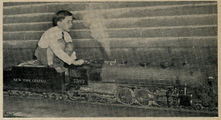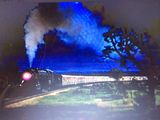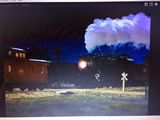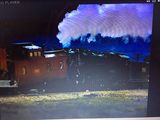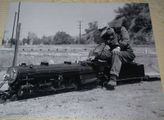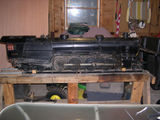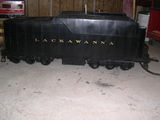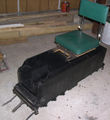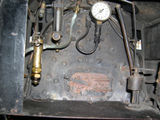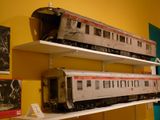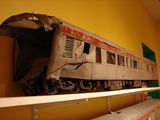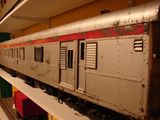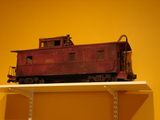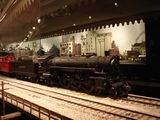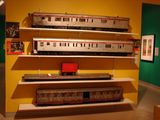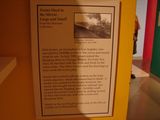One Inch Steam Locomotive Goes Hollywood: Difference between revisions
No edit summary |
|||
| (8 intermediate revisions by the same user not shown) | |||
| Line 1: | Line 1: | ||
[[Category:History]] | [[Category:History]] | ||
[[Category:Builders]] | [[Category:Builders]] | ||
[[Category:Pop Culture]] | |||
1 inch Scale Locomotive "Goes Hollywood" | 1 inch Scale Locomotive "Goes Hollywood" | ||
| Line 13: | Line 14: | ||
Here is a little story about a 1 inch scale Hudson that made the movies at the age of 13 years in "[http://en.wikipedia.org/wiki/The_Greatest_Show_on_Earth The Greatest Show on Earth]" (1952). | Here is a little story about a 1 inch scale Hudson that made the movies at the age of 13 years in "[http://en.wikipedia.org/wiki/The_Greatest_Show_on_Earth The Greatest Show on Earth]" (1952). | ||
Perhaps our readers who saw this movie will remember the locomotive that crashed the rear of the stalled show train with sufficient power to thoroughly wreck about ten cars before turning over on its side. This engine was my creation, being | Perhaps our readers who saw this movie will remember the locomotive that crashed the rear of the stalled show train with sufficient power to thoroughly wreck about ten cars before turning over on its side. This engine was my creation, being built from the tracks up, through the paper work of the design through my own patterns and castings poured from metal melted in a furnace made from an old hot water tank lined with fire brick and using an old vacuum cleaner for the air blast. Kerosene was used for fuel. | ||
With the help of a few generous friends I was able to complete this engine in 14 months with a total expenditure of $75.00. Of course this was way back in the year 1937. | With the help of a few generous friends I was able to complete this engine in 14 months with a total expenditure of $75.00. Of course this was way back in the year 1937. | ||
| Line 42: | Line 43: | ||
<gallery widths="300px" height="300px"> | <gallery widths="300px" height="300px"> | ||
File:LESmith OneInchHudson 1940.jpg|One inch scale Hudson built by L.E. Smith, shown here with his son Robert, 1940. | File:LESmith OneInchHudson 1940.jpg|One inch scale Hudson built by L.E. Smith, shown here with his son Robert, 1940. | ||
File:2014-06-22 23.03.04.jpg|L.E. Smith's 1 inch scale Hudson as it appeared in the movie "The Greatest Show on Earth", Copyright 1952 Paramount Pictures. | File:2014-06-22 23.03.04.jpg|L.E. Smith's 1 inch scale Hudson as it appeared in the movie "The Greatest Show on Earth", Copyright 1952 Paramount Pictures. | ||
File:2014-06-22 23.08.04.jpg|The Smith Hudson, pulling the second section passenger train, collides with the caboose of the first section freight train. | File:2014-06-22 23.08.04.jpg|The Smith Hudson, pulling the second section passenger train, collides with the caboose of the first section freight train. | ||
File:2014-06-22 23.10.57.jpg | File:2014-06-22 23.10.57.jpg | ||
File:LESmith on 4 8 4 by JordanAustinKarasek.jpg|L.E. Smith driving 1 inch scale 4-8-4 Number 4203 at Griffith Park. Photo provided by Jordan Austin Karasek, great-grandson of L.E. Smith. | |||
</gallery> | </gallery> | ||
| Line 56: | Line 57: | ||
== First Section Loco == | == First Section Loco == | ||
[http://discoverlivesteam.com/discoverforsale/forsale/5_Luedtke/index.htm#4-8-4 | [http://discoverlivesteam.com/discoverforsale/forsale/5_Luedtke/index.htm#4-8-4 Al Luedtke of Jim Thorpe, PA, posted the following on <i>DiscoverLiveSteam.com</i>, December 2015]: | ||
: 4.75 inch gauge DL&W 4-8-4 in 1" scale | : 4.75 inch gauge DL&W 4-8-4 in 1" scale | ||
: This locomotive was built in 1949 for the movie "The Greatest Show on Earth", and was the locomotive on the lead circus train that stopped and the following circus train with a DL&W 4-6-4 plowed into the stopped train. Locomotive was overhauled by Bruce Saylor about 10 years ago (2005) and [[Godshall's Custom Machining]] installed the hand water pump in the tender and did the piping. Engine and tender about 9 feet long and weighs around 500 pounds. | : This locomotive was built in 1949 for the movie "The Greatest Show on Earth", and was the locomotive on the lead circus train that stopped and the following circus train with a DL&W 4-6-4 plowed into the stopped train. Locomotive was overhauled by [[Bruce Saylor]] about 10 years ago (2005) and [[Godshall's Custom Machining]] installed the hand water pump in the tender and did the piping. Engine and tender about 9 feet long and weighs around 500 pounds. | ||
: Locomotive is equipped with the following: headlight, marker lights, steam generator. non-lifting injector, steam water pump, tender mounted hand water pump, 2 safety valves 100 PSI, steam brakes on drivers, front end throttle, super heated including builders plates (ALCO) and super heater plates mounted on smokebox, mechanical oiler for cylinders including super heated steam oil, large whistle disguised as air tank. One spoked driver had a broken flange and was replaced with a Box Poc driver, the original driver set is also included. | : Locomotive is equipped with the following: headlight, marker lights, steam generator. non-lifting injector, steam water pump, tender mounted hand water pump, 2 safety valves 100 PSI, steam brakes on drivers, front end throttle, super heated including builders plates (ALCO) and super heater plates mounted on smokebox, mechanical oiler for cylinders including super heated steam oil, large whistle disguised as air tank. One spoked driver had a broken flange and was replaced with a Box Poc driver, the original driver set is also included. | ||
| Line 67: | Line 68: | ||
: Not long ago, Cecil B. DeMille called on [[Little Engines]] to provide him with a 1-1/2 inch scale miniature of an old-time circus train for use in his forthcoming motion picture, "The Greatest Show on Earth". [[Little Engines]] broke all precedent and had the finished engine built. It cost Paramount $5,000. When you see it in DeMille's picture, you'll never be able to tell it from P.T. Barnum's own. | : Not long ago, Cecil B. DeMille called on [[Little Engines]] to provide him with a 1-1/2 inch scale miniature of an old-time circus train for use in his forthcoming motion picture, "The Greatest Show on Earth". [[Little Engines]] broke all precedent and had the finished engine built. It cost Paramount $5,000. When you see it in DeMille's picture, you'll never be able to tell it from P.T. Barnum's own. | ||
Al Luedtke wrote to provide more information (December 2015): | |||
: I doubt if this locomotive was built by [[Little Engines]] though they may have assisted with supplying parts, I was told that it was built by a machine shop in the Los Angeles area from plans that were supplied from ALCO for the DL&W Q-4 1631-1648 series. It has a front end throttle and super heating and it also had thermic syphons in the firebox which were removed when Bruce Saylor overhauled the locomotive. These are things that are not normally incorporated in a Little Engines locomotive. The detail is exceptional including the ALCO builders plates and the Super Heater plates on the smoke box. I have no idea what happened to the DL&W 4-6-4 model, however the circus train or parts of it were at Circus World in Florida for many years until that place shut down and I don't know what the disposition of the cars were. The cars were 1 inch scale on 4-3/4 inch track when I saw them. | |||
: Bruce Saylor had told me that he got the locomotive from Henry Todero, but unable to trace back who bought it from the movie studio or how many owners it has had in the past and what modifications were made to it. It is a very easy locomotive to steam and I have even steamed it on anthracite coal which is abundant in my area though bituminous coal is preferable. For water I have always used the water collected from our dehumidifier since there are no minerals in that to scale the boiler. | |||
<gallery widths="300px" height="300px"> | <gallery widths="300px" height="300px"> | ||
| Line 76: | Line 83: | ||
File:DLW 4-8-4 008.JPG | File:DLW 4-8-4 008.JPG | ||
File:DLW 4-8-4 004.JPG | File:DLW 4-8-4 004.JPG | ||
</gallery> | |||
== Other Equipment == | |||
<gallery widths="300px" height="300px"> | |||
File:20101214propsfromthegreatestshowonearthmoviesarasotaFL.JPG|One inch scale passenger car props used in "The Greatest Show on Earth", shown here at the Ringling Circus Museum, Sarasota, FL. Photo by Linda Braun. | |||
File:RinglingMuseum GreatestShowOnEarth CrashCloseup.jpg|Closeup of the crashed end of the passenger car. | |||
File:RinglingMuseum GreatestShowOnEarth PassengerCloseup.jpg | |||
File:RinglingMuseum GreatestShowOnEarth Caboose.jpg|1 inch scale caboose | |||
File:RinglingMuseum GreatestShowOnEarth HudsonTenderCaboose.jpg|L.E. Smith's Hudson along with a caboose. | |||
File:RinglingMuseum GreatestShowOnEarth Multiple.jpg | |||
File:RinglingMuseum GreatestShowOnEarth Plaque.jpg | |||
</gallery> | </gallery> | ||
Latest revision as of 18:30, 13 June 2022
1 inch Scale Locomotive "Goes Hollywood"
by L. E. Smith
2552 Merced Avenue
El Monte, California
The Miniature Locomotive, November-December 1954
Here is a little story about a 1 inch scale Hudson that made the movies at the age of 13 years in "The Greatest Show on Earth" (1952).
Perhaps our readers who saw this movie will remember the locomotive that crashed the rear of the stalled show train with sufficient power to thoroughly wreck about ten cars before turning over on its side. This engine was my creation, being built from the tracks up, through the paper work of the design through my own patterns and castings poured from metal melted in a furnace made from an old hot water tank lined with fire brick and using an old vacuum cleaner for the air blast. Kerosene was used for fuel.
With the help of a few generous friends I was able to complete this engine in 14 months with a total expenditure of $75.00. Of course this was way back in the year 1937.
Engine No. 5302 saw quite a bit of service until 1940 when it went into storage while I explored the work possibilities of Chicago for two years and then off to California. Finally in November, 1942 I had all 450 pounds of it shipped to my home, now in sunny California, where it was set up in El Monte. It again gave a good account of itself until 1948 when it was removed from active service. It was later sold to Paramount Pictures, Inc in 1950.
The specifications of this wonderful little locomotive are:
- Bore, 1-7/8 inch
- Stroke, 2-1/4 inch
- Drivers, 7 inch
- Baker valve gear
- Boiler, steel 8 inch diameter
- Fire box, 10 inch by 14 inch
- Height of engine, 16 inch
- Width, 11 inches
- Length, 52 inches
- Weight, 150 pounds
- Working pressure, 100 psi
- Two injectors
- Two safety valves
- Draw bar pull, 85 pounds
My son Robert is seen at the controls of the engine when he was 7 years old. Now he is 23 and a graduate student at Stanford University.
I have three other locomotives to my credit, a 3/4 inch scale Hudson No. 5301, a 1 inch scale Northern No. 4203 and a 1 inch scale Atlantic No. 3004.
Trail wreck sequence from "The Greatest Show On Earth", 1952
<videoflash>K9ITp_xSaxE</videoflash>
First Section Loco
Al Luedtke of Jim Thorpe, PA, posted the following on DiscoverLiveSteam.com, December 2015:
- 4.75 inch gauge DL&W 4-8-4 in 1" scale
- This locomotive was built in 1949 for the movie "The Greatest Show on Earth", and was the locomotive on the lead circus train that stopped and the following circus train with a DL&W 4-6-4 plowed into the stopped train. Locomotive was overhauled by Bruce Saylor about 10 years ago (2005) and Godshall's Custom Machining installed the hand water pump in the tender and did the piping. Engine and tender about 9 feet long and weighs around 500 pounds.
- Locomotive is equipped with the following: headlight, marker lights, steam generator. non-lifting injector, steam water pump, tender mounted hand water pump, 2 safety valves 100 PSI, steam brakes on drivers, front end throttle, super heated including builders plates (ALCO) and super heater plates mounted on smokebox, mechanical oiler for cylinders including super heated steam oil, large whistle disguised as air tank. One spoked driver had a broken flange and was replaced with a Box Poc driver, the original driver set is also included.
Charles N. Barnard wrote the following for True magazine, May 1951:
- Not long ago, Cecil B. DeMille called on Little Engines to provide him with a 1-1/2 inch scale miniature of an old-time circus train for use in his forthcoming motion picture, "The Greatest Show on Earth". Little Engines broke all precedent and had the finished engine built. It cost Paramount $5,000. When you see it in DeMille's picture, you'll never be able to tell it from P.T. Barnum's own.
Al Luedtke wrote to provide more information (December 2015):
- I doubt if this locomotive was built by Little Engines though they may have assisted with supplying parts, I was told that it was built by a machine shop in the Los Angeles area from plans that were supplied from ALCO for the DL&W Q-4 1631-1648 series. It has a front end throttle and super heating and it also had thermic syphons in the firebox which were removed when Bruce Saylor overhauled the locomotive. These are things that are not normally incorporated in a Little Engines locomotive. The detail is exceptional including the ALCO builders plates and the Super Heater plates on the smoke box. I have no idea what happened to the DL&W 4-6-4 model, however the circus train or parts of it were at Circus World in Florida for many years until that place shut down and I don't know what the disposition of the cars were. The cars were 1 inch scale on 4-3/4 inch track when I saw them.
- Bruce Saylor had told me that he got the locomotive from Henry Todero, but unable to trace back who bought it from the movie studio or how many owners it has had in the past and what modifications were made to it. It is a very easy locomotive to steam and I have even steamed it on anthracite coal which is abundant in my area though bituminous coal is preferable. For water I have always used the water collected from our dehumidifier since there are no minerals in that to scale the boiler.
